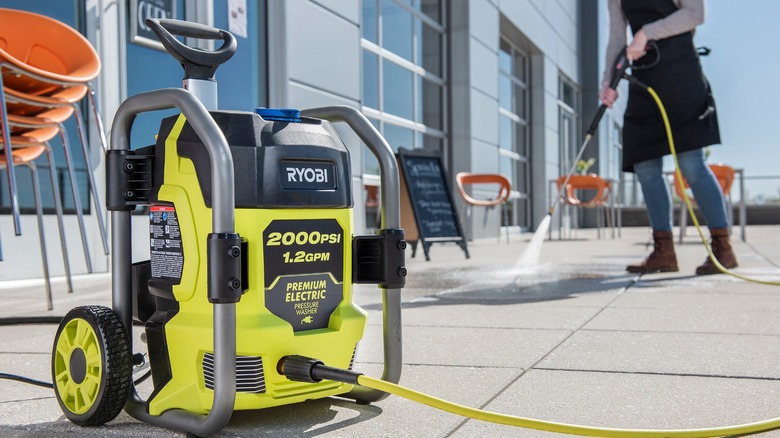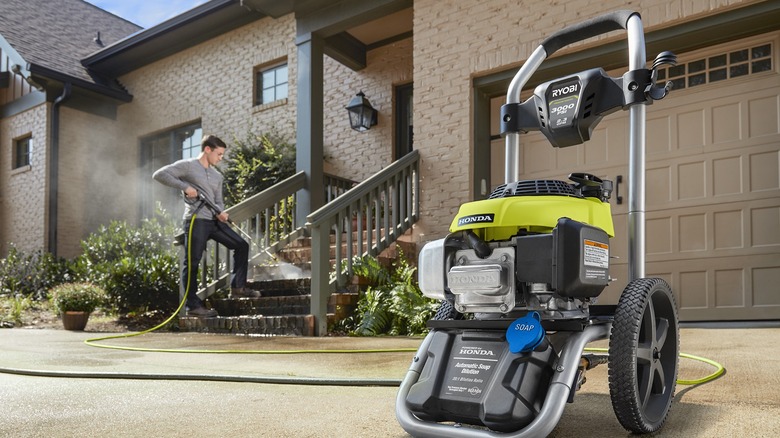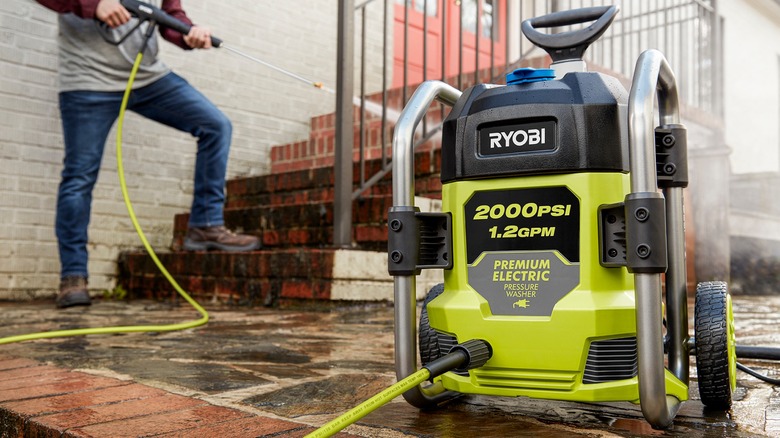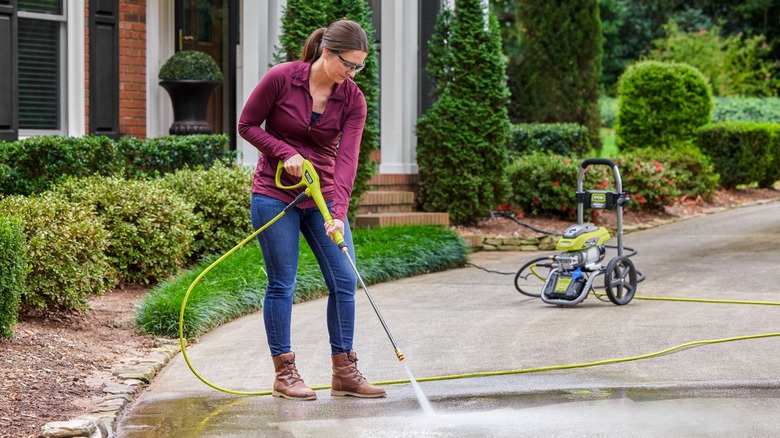How To Clean And Maintain Your Ryobi Pressure Washer (And What Not To Do)
If you're a DIYer, someone who works with tools professionally, or even a casual hobbyist, you've probably heard of Ryobi. The company is one of the most popular power tool brands on the market, supplying everything from drills and impact drivers to lawn equipment and pressure washers. Ryobi has an exclusive partnership with Home Depot, meaning that if you're shopping for Ryobi tools in person, you're limited to the famous orange hardware store. However, that exclusivity doesn't apply to Internet sales, and there are plenty of great places to buy Ryobi devices online.
If you're already a Ryobi fan and own some of the brand's product, you may be wondering how to properly maintain your Ryobi tools. While cleaning some devices, like hand tools, may be straightforward, cleaning things like pressure washers can be slightly more confusing. Fortunately, Ryobi provides detailed instructions for maintaining its products. We'll explain how to find that information for yourself, but we'll also break it down for you in simple steps to make the process quick and easy.
Here's how to clean and maintain your Ryobi pressure washer, and what not to do.
How to prep your Ryobi pressure washer for cleaning
Before you can start cleaning your Ryobi pressure washer, there are a few steps you need to take to prepare your device and your workspace. First, you should gather your supplies. Ryobi encourages users to wear eye protection at all times when servicing their equipment. Outside of standard safety gear, you'll also need a garden hose and a few rags or sponges.
Next, you'll need to prepare the pressure washer for cleaning. The first step is shutting off the engine and allowing it to cool completely. Wait for all moving parts to stop rotating and disconnect the washer from any power sources if applicable. If you own a gas-powered pressure washer, you need to disconnect the spark plug wire and keep it away from the plug during maintenance. If it's an electric model, remove the battery pack. Finally, pull the wand's trigger to release the water pressure and wait for the water to drain from the device.
Skipping these steps can not only cause damage to your pressure washer, but it can also void your warranty and cause severe injury.
How to clean and store your Ryobi pressure washer
After collecting the necessary supplies and safety gear, disconnecting your device from its power source, and allowing the engine to cool down and all moving parts to stop, you're ready to clean your Ryobi pressure washer. The steps to clean your washer may differ slightly depending on the model and power source. We'll provide a general outline for electric, battery, and gas-powered pressure washers. However, you can find specific model information and user manuals by visiting the Ryobi website, locating your specific product, and clicking on the support tab.
First, disconnect the pressure washer nozzle from the spray wand. Use compressed air or a small poker tool to remove any debris clogging your pressure washer nozzle. Backflush the nozzle by pressing your garden hose to the nozzle face and allowing water to run backward out of the tool through the hose. Then reattach the nozzle to the wand, reconnect the water supply, turn it on, and start the engine to ensure water flows smoothly through the nozzle.
The above steps represent a general outline for cleaning your Ryobi pressure washer. Remember that the process to clean your device may differ, depending on its model, and you should verify the cleaning steps independently. Outside of routinely cleaning your pressure washer nozzle, Ryobi encourages users to monitor their tools for signs of damage, paying particular attention to things like loose nuts and bolts and missing parts. When storing your pressure washer, make sure to fully drain it, remove the battery pack if there is one, and keep the device in an area that won't experience extreme heat or freezing temperatures.
What not to do when cleaning your Ryobi pressure washer
There's a handful of things you should not do when cleaning your Ryobi pressure washer. First of all, Ryobi recommends that you avoid using solvents to clean your pressure washer, especially the plastic parts. Instead, the company encourages users to clean sensitive components with clean cloths or rags. Additionally, you should prevent chemicals like brake fluid, gasoline, penetrating oils, or petroleum-based products from coming into contact with your Ryobi pressure washer. If solvents or any of the above chemicals come into contact with your device, they can cause damage to sensitive components.
You should also remember that many of your Ryobi pressure washer parts aren't user-serviceable. That means that you shouldn't attempt to modify or replace any components with non-Ryobi parts or disassemble or repair components like the pump by yourself. Doing so may cause damage to the device, cause personal injuries, and void your warranty. Finally, remember to never remove your pressure washer's nozzle without turning off the water supply first. Allow the water to drain completely before servicing or cleaning the device, and never point the nozzle at your face or someone else's, as the internal springs could self-eject and cause severe injury.



